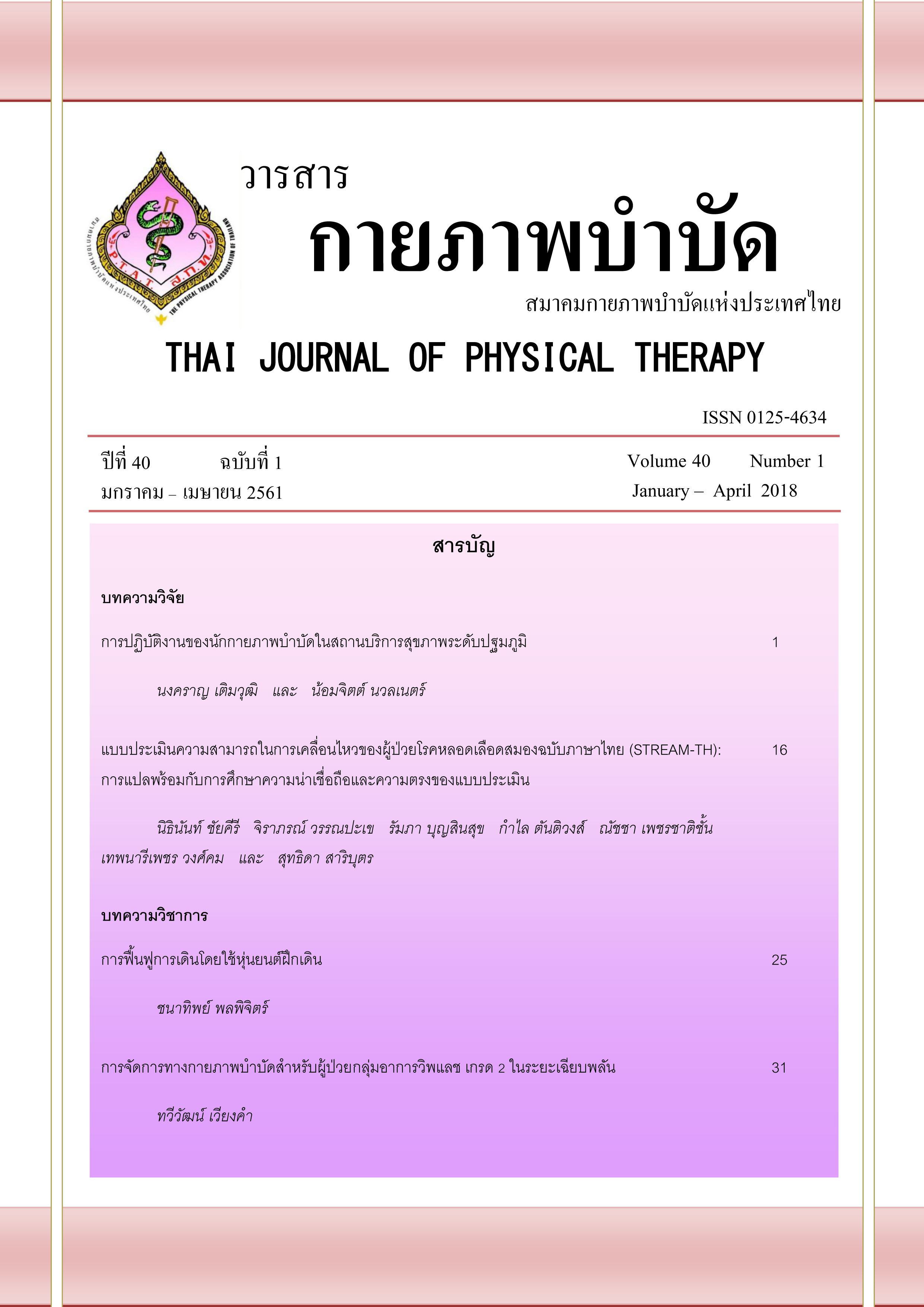การฟื้นฟูการเดินโดยใช้หุ่นยนต์ฝึกเดิน
Main Article Content
บทคัดย่อ
หุ่นยนต์ฝึกเดินเป็นเทคโนโลยีใหม่ที่มีมากว่า 20 ปี โดยได้รับการคิดค้นและพัฒนาเพื่อแก้ไขข้อจำกัดในการฝึกเดินด้วยการกายภาพบำบัดแบบดั้งเดิม ซึ่งการกายภาพบำบัดด้วยวิธีการฝึกเดินแบบดั้งเดิมนั้นผู้ป่วยต้องสามารถยืนได้ จึงจะได้รับการฝึกเดิน นอกจากนี้ แรงเกร็ง (spasticity) และขนาดตัวของผู้ป่วยยังเป็นอุปสรรคต่อการฝึกเดินแบบดั้งเดิมอีกด้วย ปัจจัยเหล่านี้ส่งผลให้ผู้ป่วยไม่สามารถฝึกเดินได้อย่างเต็มความสามารถ โดยนักกายภาพบำบัดซึ่งเป็นบุคคลสำคัญที่ทำหน้าที่ในการฟื้นฟูผู้ป่วย ต้องใช้กำลังเพิ่มขึ้นมากในการฝึกเดินแบบดั้งเดิมให้กับผู้ป่วยที่มีแรงเกร็งมาก หรือมีขนาดตัวใหญ่และมักพบว่านักกายภาพบำบัดได้รับบาดเจ็บภายหลังการฝึก ดังนั้น จึงได้มีการประดิษฐ์หุ่นยนต์สำหรับฝึกเดินเพื่อลดการใช้แรงงานและลดการบาดเจ็บของนักกายภาพบำบัด นอกจากนี้ ยังช่วยส่งเสริมให้ผู้ป่วยได้รับการฟื้นฟูการเดินได้เร็วขึ้น รวมถึงเพิ่มศักยภาพในการเดินโดยที่นักกายภาพบำบัดไม่ต้องออกแรงมาก โดยในปัจจุบันพบว่าหุ่นยนต์ฝึกเดินได้รับการยอมรับว่าทำให้การฝึกเดินมีประสิทธิภาพมาก อย่างไรก็ตาม หุ่นยนต์ฝึกเดินเป็นเทคโนโลยีที่เริ่มมีการประดิษฐ์และคิดค้นขึ้นจากต่างประเทศ การนำเข้าเทคโนโลยีนี้มาใช้จึงมีต้นทุนที่สูงมาก ส่งผลให้มีการเข้าถึงเทคโนโลยีนี้ได้ยาก อีกทั้งยังเป็นเรื่องใหม่สำหรับประเทศไทย นักกายภาพบำบัดไทยจึงยังขาดความรู้ความเข้าใจเกี่ยวกับการใช้หุ่นยนต์ในการฝึกเดิน
บทความนี้ประกอบด้วยความรู้เกี่ยวกับหุ่นยนต์ทั้งหมดที่ใช้ในการฟื้นฟูการเคลื่อนไหว การประยุกต์ใช้ทางคลินิค และหลักฐานทางการวิจัย วัตถุประสงค์ของบทความนี้เพื่อพัฒนาความรู้ ความเข้าใจทางด้านเทคโนโลยีหุ่นยนต์กับการรักษาทางกายภาพบำบัด ทำให้นักกายภาพบำบัดไทยมีความรู้ทันสมัย ก้าวทันเทคโนโลยีใหม่ๆ และสามารถนำมาประยุกต์ใช้ได้อย่างถูกต้องและเหมาะสม
Article Details
เอกสารอ้างอิง
2. Diaz I, Gil JJ, Sanchez E. Lower-Limb Robotic Rehabilitation: Literature Review and Challenges. Journal of Robotics 2011;1-11.
3. Louie DR, Eng JJ. Powered Robotic Exoskeletons in Post-Stroke Rehabilitation of Gait: A Scoping Review. J NeuroEng Rehabil 2016;13:1-10.
4. Chang WH, Kim YH. Robot-Assisted Therapy in Stroke Rehabilitation. JoS 2013; 15(3): 174-81.
5. Knaepen K, Mierau A, Swinnen E, Tellez HF, MIchielsen M, Kerckhofs E, et al. Human-Robot Interaction: Does Robotic Guidance Force Affect Gait-Related Brain Dynamics during Robot-Assisted Treadmill Walking? PLoS One 2015;1-19.
6. Kammen KV, Boonstra A, Messelink HR, Otter Rd. The Combined Effects of Body Weight Support and Gait Speed on Gait Related Muscle Activity: A Comparison between Walking in the Lokomat Exoskeleton and Regular Treadmill Walking. PLoS One 2014; 9:1-12.
7. Taveggia G, Borboni A, Mule C, Villafane JH, Negirini S. Conflicting Results of Robot-Assisted versus Usual Gait Training during Postacute Rehabilitation of Stroke Patients: A Randomized Clinical Trial. Int J Rehabil Res 2016;39(1):29-35.
8. Chanubol R, Wongphaet P, Panichareon L, Chavanich N. Gait rehabilitation in Subacute Hemiparetic Stroke: Robot-Assisted Gait Training versus Conventional Physical Therapy J Thai Rehabil Med 2012, 22(2):42-50.
9. Guertin PA, Central Pattern Generator for Locomotion: Anatomical, Physiological, and Pathophysiological Considerations. Front Neurol 2013;(3):1-15.
10. Dutra CMR, Dutra CMR, Moser ADL, Manffra EF. Locomotor Training with Partial Body Weight Support in Spinal Cord Injury Rehabilitation: Literature Review. Fisioter Mov 2013; 26(4): 907-20.
11. Riener R, Lunenburger L, Maier IC, Colombo G, Dietz V. Locomotor Training in Subjects with Sensori-Motor Deficits: An Overview of the Robotic Gait Orthosis Lokomat. J Healthc Eng 2010;1:197-216.
12. Knikou M. Plasticity of Corticospinal Neural Control after Locomotor Training in Human Spinal Cord Injury. Neural Plast 2012;1-13.
13. Shin JC, Kim JY, Park HK, Kim NY. Effects of Robotic-Assisted Gait Training in Patients with Incomplete Spinal Cord Injury. Ann Rehabil Med 2014;38(6)719-25.


